History of Vancouver facts for kids
The history of Vancouver goes back thousands of years. The first people arrived here after the last ice age. Vancouver is in British Columbia, Canada. It's located near the Fraser River and on the waters of the Strait of Georgia, Howe Sound, and Burrard Inlet. For a very long time, Vancouver has been a place where people meet, trade, and live.
People have lived in the area now called the Lower Mainland for 8,000 to 10,000 years. This was when the huge glaciers from the last ice age started to melt away. The First Nations call this area S'ólh Téméxw. Archeological findings show that people had seasonal camps near the mouth of the Fraser River even back then.
The first Europeans to explore this area were Spanish Captain José María Narváez in 1791 and British Captain George Vancouver in 1792. But Europeans didn't start settling here until much later, in 1862. The city grew very fast after the Canadian Pacific Railway (CPR) finished its cross-Canada train line in the late 1880s. Many Chinese settlers came to the area after the CPR was built. Later, more people from Europe moved west. With global air travel, people from Asia and many other parts of the world also began to arrive.
Contents
Early History of Vancouver
First Nations Settlements
The Indigenous peoples of the Pacific Northwest Coast are the first people who lived in what is now Vancouver. The city is on the traditional lands of three Coast Salish groups: the Squamish (Sḵwxwú7mesh), the Tsleil-Waututh, and the Xwméthkwyiem (also known as Musqueam).
The Musqueam people live on the southern shores of Vancouver, along the Fraser River. The Squamish people have villages in North Vancouver, and their territory also includes Howe Sound and the area up to Whistler. The Tsleil-Waututh people have their main community further down the Burrard Inlet. The Musqueam and Tsleil-Waututh historically spoke a dialect of the Halkomelem language. The Squamish language is different but related, and it's closer to the language of their Shishalh neighbors in Sechelt. Historically, the area where Vancouver is now was used by these groups to gather food and materials.
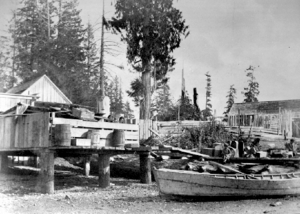
The Musqueam have lived continuously at their main winter village, Xwméthkwyiem, near the mouth of the Fraser River, for 4,000 years. Vancouver's natural environment, with its many plants and animals, provided lots of food and materials. This has supported the people for over 10,000 years. When Europeans first arrived, the Squamish people had villages in areas like Stanley Park, Kitsilano, and the False Creek area, as well as Burrard Inlet. The Tsleil-Waututh were also settled on Burrard Inlet when George Vancouver arrived in 1792.
The largest villages were at X̱wemelch'stn (near the Capilano River) and at Musqueam. X̱wáýx̱way was a big village in Stanley Park. Another large Squamish community grew at Eslha7an, near Mosquito Creek, after a Catholic mission was built there. Along False Creek, near the Burrard Bridge, there was once a large village called Senakw.
The Indigenous peoples of the Northwest Coast had a very complex culture. They had an economic system that encouraged hard work, gathering wealth, and sharing it. Their winter villages in Vancouver were made of large plankhouses built from Western Red Cedar wood. Special ceremonies called potlatches were common in the summer and winter. These ceremonies are still an important part of their social and spiritual life today.
European Exploration of the Coast
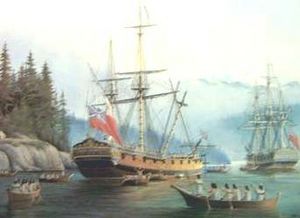
Spanish Captain José María Narváez was the first European to explore the Strait of Georgia in 1791. He landed at Point Grey and entered Burrard Inlet. The next year, in 1792, British Captain George Vancouver met the Spanish explorers Dionisio Alcalá Galiano and Cayetano Valdés y Flores near Point Grey. Together, they explored the Strait of Georgia further. Vancouver also explored Puget Sound near what is now Seattle. Vancouver and his officer Peter Puget arrived at the future city of Vancouver before the Spanish. They first landed at what Vancouver later named Point Grey. Puget informally called it Noon Breakfast Point. Puget's name was officially given to the southwest tip of Point Grey in 1981. Simon Fraser was the first European to reach the area by land, coming down the river named after him in 1808.
Even with the Fraser Canyon Gold Rush in 1858–59, few Europeans settled on Burrard Inlet and English Bay before the 1860s. This was partly because the main way to get to the BC interior was through New Westminster and the Fraser River. Also, the Squamish chiefs had strong control over the area. Robert Burnaby and Moberly camped and searched for coal in what is now Coal Harbour in the summer of 1859. They had a friendly relationship with the First Nations people there. Robert Burnaby wrote to his family, "our time has been spent exploring this Inlet, which I believe will become one of the greatest naval centers and trade hubs in this part of the world."
European Settlement and Growth
The first non-Indigenous settlement within Vancouver's city limits was around 1862 at McCleery's Farm, in the Southlands area.
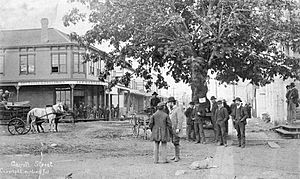
Logging was the first big industry along Burrard Inlet, where Vancouver's seaport is now. The first sawmill started in 1863 at Moodyville, a planned community built by American lumber businessman Sewell Moody. In 1915, Moodyville became a municipality and was renamed "North Vancouver." The name Moodyville is still used for the Lower Lonsdale area today. The first lumber was exported in 1865, shipped to Australia. In 1867, the first sawmill on the south shore of Burrard Inlet, Hastings Mill, began producing lumber. It was located in the Squamish village of K'emk'emeláy, at what is now the foot of Dunlevy Avenue.
The biggest trees in the world grew along the south shores of False Creek and English Bay. They provided wood for ships all over the world, including masts for the Royal Navy. One famous order was for the Emperor of China: dozens of huge beams from the Jericho area were used to build The Gate of Heavenly Peace in the Forbidden City, Beijing. Millworkers and loggers came from many places, mostly Scandinavia and Nootka. Squamish people usually did not work in the mills at first.
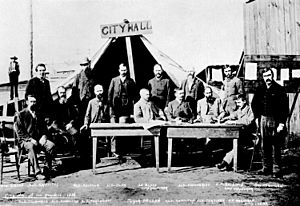
In 1867, a former river pilot named John (Jack) Deighton opened a small saloon on the beach. It was about a mile west of the sawmill, where the mill's "dry" (no alcohol) rules ended. His place was popular, and a well-used path quickly formed between the mill and the saloon. This path is now Alexander Street. Deighton's nickname, Gassy Jack, came from his love of talking. Many men started living near the saloon, and the settlement quickly became known as Gassy's Town, which was soon shortened to "Gastown."
In 1870, the government of British Columbia noticed the growing settlement. They sent a surveyor to officially plan a townsite named Granville, honoring the British Colonial Secretary, Lord Granville. However, people still commonly called it Gastown, which is still the name for that part of the city today.
The new townsite had a natural harbor. Because of this, the Canadian Pacific Railway chose it as the end point for their transcontinental railway. This railway was a condition for British Columbia joining Canada in 1871. The CPR president, William Van Horne, thought Granville was not a good name because of Gastown's reputation. He strongly suggested "Vancouver" instead. He felt people in Toronto and Montreal knew where Vancouver Island was, but not Granville.
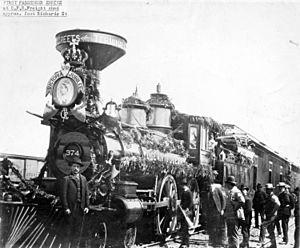
With its new name, the city was officially created on April 6, 1886. Two months later, on June 13, a huge fire destroyed most of the city in just twenty-five minutes. This event, known as the Great Vancouver Fire, was actually helpful in the long run. The city was rebuilt with modern water, electricity, and streetcar systems.
Things recovered quickly after the fire. The first regular transcontinental train from Montreal arrived at a temporary stop in Port Moody in July 1886. Train service to Vancouver itself began in May 1887. In 1887, Vancouver's population was 1,000. By 1891, it grew to 14,000, and by 1901, it was 26,000. The population reached 120,000 by 1911.
The Port of Vancouver became very important internationally. It was a key part of the All-Red Route, a trade network of the British Empire. The combination of steamships and the CPR railway greatly shortened shipping times from Asia to London. The new city became a major place for investments from British and German companies. The completion of the Panama Canal at first reduced Vancouver's shipping traffic. But by the 1920s, lower shipping costs made it possible to send even prairie grain west through Vancouver to Europe, in addition to grain shipped to Asia.
Vancouver from 1900 to 1940
Economy and Transportation
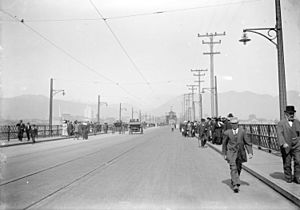
When the Panama Canal opened in 1914, Vancouver's seaport could compete with other big international ports for global trade. It offered a new route to Europe. In the 1920s, the provincial government successfully fought to remove unfair freight rates for goods transported by rail through the mountains. This made Gerry McGeer, a young lawyer, famous. As a result, grain from the prairies came west through Vancouver instead of being shipped through eastern ports. The federal government also helped develop the Vancouver Harbour. When Ballantyne Pier was finished in 1923, it was the most advanced port in the British Empire.
After World War I, railway companies, lumber exporters, and other businesses on the waterfront formed the Shipping Federation of British Columbia. This group managed worker relations. The Federation strongly opposed unions, defeating strikes until the ILWU was formed after World War II. By the 1930s, trade through the port was the biggest part of Vancouver's economy.
The fast growth of cars and trucks after 1910 led to new bridges over False Creek. These included the Granville Street Bridge (1889, rebuilt 1954), the Burrard Street Bridge (1932), and the Cambie Street Bridge (1912, rebuilt 1984). Car traffic to North Vancouver became easier with the first Second Narrows Bridge in 1925 and the Lions Gate Bridge in 1938.
City Development and Neighborhoods
The first thing the City Council did at its first meeting in 1886 was to ask for a large military area (1,000 acres) to be used as a park. This might seem strange for a new city with lots of green space. However, the West End was planned to be a fancy neighborhood by people connected to the CPR. They didn't want small settlements there to grow into another working-class area. This also started the process of removing people who lived in the park area in the 1920s to create a "pristine" park. Over time, the Parks Board has started to bring Native artifacts back into the park.
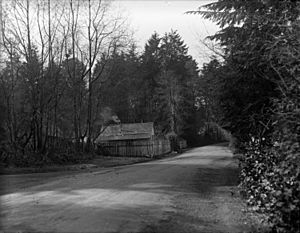
In 1877, just six years after British Columbia joined Canada, a proposal for a provincial university was made. The British Columbia University Act of 1908 officially created a provincial university, though its location wasn't set yet. It was first called McGill University College of British Columbia. In 1910, it was chosen to be built at Point Grey, but World War I delayed construction. The now-independent University of British Columbia began operating in 1915.
In 1911, Vancouver grew by joining with Hastings Townsite (originally New Brighton). The former municipality's name lives on in the Hastings-Sunrise neighborhood. Residents of the nearby Squamish village Sen̓áḵw were forced to leave as part of this expansion in 1913.
By the years between the World Wars, other working-class neighborhoods grew, like Mount Pleasant, South Vancouver, and Grandview-Woodland. Even the West End became less exclusive. CPR developers then created new areas for the city's wealthy elite. Point Grey was formed in 1908 for this purpose. Shaughnessy Heights was developed only for the "richest and most important citizens." They had to spend at least $6,000 on new homes that followed specific style rules. These patterns of economic separation were set by 1929 when Point Grey and South Vancouver joined with Vancouver.
The Great Depression in Vancouver
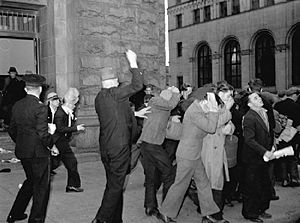
British Columbia was hit very hard by the Great Depression. While Vancouver avoided going bankrupt, other nearby cities like North Vancouver and Burnaby were not as lucky. Vancouver also became a destination for thousands of unemployed young men who traveled across Canada looking for work, often by riding on trains. This was the end of the line for them. "Hobo jungles" (makeshift camps) appeared early in the depression, where men built shelters from whatever they could find. The largest of these was closed because it was said to be unsanitary.
Vancouver was also the starting point for protests led by Communists throughout the decade. These protests ended with the relief camp strike and the On-to-Ottawa Trek in 1935. Protesters also led strikes in other industries, like the 1935 waterfront strike. Many people from Vancouver also joined the Mackenzie-Papineau Battalion to fight against fascism in the Spanish Civil War.
City Celebrations
Vancouver had big celebrations in 1936. This was partly to boost city spirit during the depression and to celebrate Vancouver's Jubilee (50th anniversary). Mayor McGeer caused some debate by organizing expensive celebrations when the city was almost bankrupt and city workers were getting much less pay. However, many people supported him, believing a celebration would help the city's success. While some big expenses were criticized, like an "ugly" fountain in Stanley Park's Lost Lagoon, others received strong support, such as building the new (and current) city hall on Cambie Street. The next big city celebration was the 1939 Royal visit by the King and Queen. This visit marked the end of the depression and the likely start of another world war.
Vancouver During World War II

When World War II started, it brought big changes to Vancouver. Local military groups quickly recruited more members. For example, Vancouver's Seaforth Highlanders of Canada had a battalion overseas in England within four months. They fought in Europe until the end of the war. Other groups like the British Columbia Regiment and the 15th Field Regiment RCA also helped with the war effort. Huge new spending by the government and jobs in the military and factories gave a much-needed economic boost after the Great Depression of the 1930s.
Many products and weapons for the war were made in the Vancouver area. These included minesweepers and corvettes for the Royal Canadian Navy. Anti-aircraft guns were made in Burnaby, and the Boeing factory in nearby Richmond produced parts for B-29 bomber aircraft. The old defenses for Vancouver Harbour were improved with coastal artillery at Point Grey, Stanley Park, under the Lion's Gate Bridge, and at Point Atkinson.
In 1942, a few months after the Japanese attack on Pearl Harbor, Japanese Canadians were "evacuated" from the West Coast. They were placed in holding areas like the barns at Hastings Park and then sent to camps in the interior by the federal government. This was done under the War Measures Act. Because people feared bombing and poison gas attacks, a blackout was put in place on the West Coast in 1942. School children and others were given gas masks. Japan did attack the West Coast. A Japanese submarine shelled Estevan Point Lighthouse, and Japanese balloon bombs were floated across the Pacific Ocean. These balloon bombs landed as close to Vancouver as Point Roberts, but their existence was kept secret until very late in the war.
Vancouver from 1950 to Today
CBUT, the oldest television station in Western Canada, began broadcasting in December 1953. The Oak Street Bridge, which connects Vancouver to Richmond across the Fraser River, opened in 1957. The Second Narrows Bridge (1925) and the Lions Gate Bridge (1938) had already connected Vancouver to the North Shore. The Ironworkers Memorial Second Narrows Crossing followed in 1960. The last parts of the British Columbia Electric Railway's streetcar and interurban rail system were removed in 1958.
Another major bridge across the Fraser River, the Port Mann Bridge to Surrey, opened in 1964. Two new universities were started: the British Columbia Institute of Technology in 1964 and Simon Fraser University in 1965. Both have smaller campuses in Vancouver. Residents of Strathcona – mostly Chinese people – formed a protest movement led by community activist Mary Lee Chan. They stopped the building of a freeway that would have destroyed their neighborhood. In 1967, the Metro Vancouver Regional District was created. Greenpeace, one of the world's leading environmental organizations, was founded in Vancouver in 1971.
In 1968, the Canada Council gave a grant to Joachim Foikis of Vancouver to "bring back the old tradition of town fool." He often went to city council meetings dressed as a traditional jester, adding humor and interest to the meetings. This brought international attention to Vancouver.
Disc sports started in Vancouver at Kitsilano Beach in 1974 with the Vancouver Open Frisbee Championships.
The airport on Sea Island continued to grow. This led to building another bridge across the Fraser River, the Arthur Laing Bridge, which opened in 1975.
Pacific Central Station replaced Waterfront Station as the main railway station in 1979. Waterfront Station was then turned into the terminal for SeaBus and the future SkyTrain (which opened six years later). Canada's first domed stadium, BC Place, opened in 1983. The SkyTrain, BC Place Stadium, Science World, Canada Place, and the Plaza of Nations were all built for Expo 86. This important international event was the last World's Fair held in North America and was very successful, with over 22 million visits.
In 1951, Vancouver's population was 562,000. By 1971, it reached 1,000,000. The Park Royal Shopping Centre in West Vancouver became the city's first in 1950. Empire Stadium was built to host the 1954 British Empire Games. Vancouver became the western end of the new CBC national television network in 1958 and the western hub of the newly completed Trans-Canada Highway in 1962. The huge Tsawwassen Ferry Terminal was built in 1959 for ferry service to southern Vancouver Island. The nearby Roberts Bank Superport coal terminal was finished in the late 1960s. A second Second Narrows Bridge was built in 1960, and the W.A.C. Bennett Dam was finished in 1967.
The opening of the Queen Elizabeth Theatre in 1959 and Simon Fraser University in 1965 made the city's cultural life richer. Canada's first purpose-built auto racing track, the Westwood Motorsport Park, was built in nearby Coquitlam that same year. The first McDonald's restaurant outside the United States opened in Richmond in 1967.



